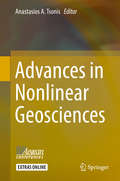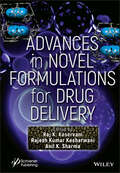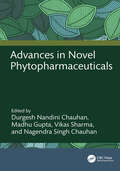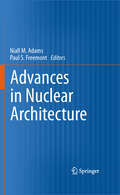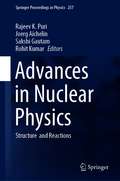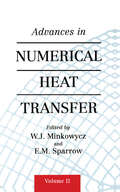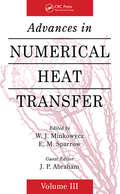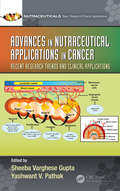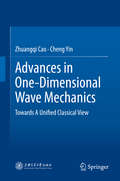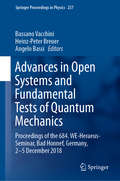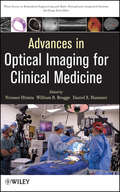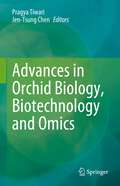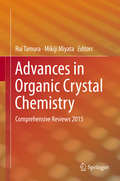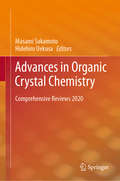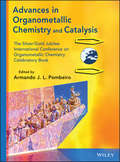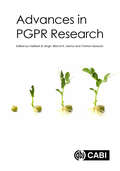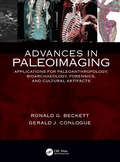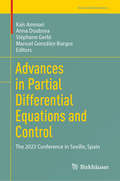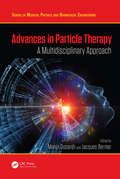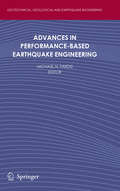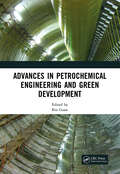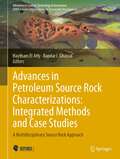- Table View
- List View
Advances in Nonlinear Geosciences
by Anastasios A. TsonisAdvances in Nonlinear Geosciences is a set of contributions from the participants of "30 Years of Nonlinear Dynamics" held July 3-8, 2016 in Rhodes, Greece as part of the Aegean Conferences, as well as from several other experts in the field who could not attend the meeting. The volume brings together up-to-date research from the atmospheric sciences, hydrology, geology, and other areas of geosciences and presents the new advances made in the last 10 years. Topics include chaos synchronization, topological data analysis, new insights on fractals, multifractals and stochasticity, climate dynamics, extreme events, complexity, and causality, among other topics.
Advances in Novel Formulations for Drug Delivery
by Anil K. Sharma Raj K. Keservani Rajesh Kumar KesharwaniADVANCES in NOVEL FORMULATIONS for DRUG DELIVERY The 27 chapters describe novel strategies for drug/nutraceutical delivery and embrace the development of formulations with herbal ingredients, while also highlighting disease therapeutics. Drug delivery technology has witnessed many advancements purported to cater to the customized needs of its ultimate beneficiaries—the patients. Today, dosage forms are not confined to conventional tablets, capsules, or injectables, but have evolved to cover novel drug carriers such as particulates, vesicles, and many others. Nanotechnological advancements have played a major role in this paradigm shift in ways of delivering active pharmaceutical ingredients. A new dimension in the use of food as medicine has also gained prominence in recent years. A portmanteau of nutrition and pharmaceuticals is “nutraceuticals,” also known as functional foods and dietary supplements. The technologies which were earlier included in drug delivery have been attempted for the delivery of nutraceuticals as well. Herbal actives have received increased attention due to their low risk-to-benefit ratio. The field of drug delivery is quite dynamic in nature, as witnessed by its evolution from conventional dosage forms to nanotechnology-assisted drug products. A variety of formulations via different drug delivery routes have been developed to treat/cure/mitigate diseases or disorders. This book, comprising of 27 chapters, is a thorough compilation of information relevant to drug delivery systems with an emphasis on products based on nanotechnology. Audience Researchers, scientists, industry professionals, formulators and product developers, regulatory agencies in a variety of settings including novel drug delivery research laboratories, pharmaceutical, and pharmacy industries, biomedical sciences, food and nutraceuticals manufacturers, and nanotechnology.
Advances in Novel Phytopharmaceuticals
by Madhu Gupta Durgesh Nandini Chauhan Vikas Sharma Nagendra Singh ChauhanAdvances in Novel Phytopharmaceuticals covers the current aspects of the development of novel herbal formulations and summarizes their type of active components, biological activity, applications, and toxicity associated with novel herbal formulations. Such distinct types of novel herbal formulations are described to have remarkable advantages over conventional formulations of plant actives and extracts. The book also covers the various herbal phytoconstituents used for novel drug delivery applications. These novel herbal formulations can be used more uprightly and with enhanced efficacy by incorporating them into modern dosage forms. This can be accomplished by designing novel drug delivery systems for herbal ingredients. This book provides key information for everyone interested in novel phytodrug delivery systems and drug discovery, including medicinal chemists, cosmetic experts, nutritionists, toxicologists, drug formulators, and healthcare professionals. Students, professors, and researchers working in pharmaceutical sciences and beyond will also find the book useful.We will also focus on patent filed, technology transfer, market potential, and regulatory aspects of herbal nanomedicines, if any. Research in this area is still in the exploratory stage, and in the market there are no books available that summarize all the contents of the research. As such, we will try to make our full contribution to this area. This book is the continuation of a first volume and readers and the target audience will gain all the latest knowledge in the subject.Aims and scopeð To understand the basic information and application of phytoconstituentsð To understand the various phytoconstituents-based formulations for disease managementð To understand the herbal drugs used for cosmetic applicationsð To understand the phytodrug delivery systems and their applicationsð To provide detailed knowledge about the technical aspects of formulationð To update readers with the latest research progress in this emerging research areað To provide the details about the patents filed, technology transfer, market potential, and regulatory aspects for the same
Advances in Nuclear Architecture
by Niall M. Adams Paul S. FreemontThis book provides a snapshot of the state-of-the art in the study of mammalian cell nuclear architecture, and features a diverse range of chapters written by top researchers. A key aspect is an emphasis on precise and repeatable quantitative analysis and simulation in addition to the more familiar biological perspective. The fusion of such material frames the future of the discipline. Quantitative contributions stress reproducible and robust 3D analysis, using a variety of tools ranging from point pattern analysis to shape registration methods. Biological insights include the role of nuclear subdomains in cancer, nuclear molecular motors, and a holistic view of gene transcription.
Advances in Nuclear Physics: Structure and Reactions (Springer Proceedings in Physics #257)
by Rohit Kumar Rajeev K. Puri Joerg Aichelin Sakshi GautamThis volume comprises select peer-reviewed papers from the Indo-French Workshop on Multifragmentation, Collective Flow, and Sub-Threshold Particle Production in Heavy-Ion Reactions held at the Department of Physics, Panjab University, Chandigarh, India in February, 2019. The contents highlight latest research trends in intermediate energy nuclear physics and emphasize on the various reaction mechanisms which take place in heavy-ion collisions. The chapters contribute to the understanding of interactions that govern the dynamics at sub-nucleonic level. The book includes contributions from global experts hailing from major research facilities of nuclear physics, and provides a good balance between experimental and theoretical model based studies. Given the range of topics covered, this book can be a useful reference for students and researchers interested in the field of heavy-ion reactions.
Advances in Numerical Heat Transfer, Volume 2: Advances In Numerical Heat Transfer Volume V (Computational And Physical Processes In Mechanics And Thermal Sciences Ser.)
by W. MinkowyczThis volume discusses the advances in numerical heat transfer modeling by applying high-performance computing resources, striking a balance between generic fundamentals, specific fundamentals, generic applications, and specific applications.
Advances in Numerical Heat Transfer, Volume 3 (Computational & Physical Processes in Mechanics & Thermal Scienc)
by W. J. MinkowyczDefinitive Treatment of the Numerical Simulation of Bioheat Transfer and Fluid FlowMotivated by the upwelling of current interest in subjects critical to human health, Advances in Numerical Heat Transfer, Volume 3 presents the latest information on bioheat and biofluid flow. Like its predecessors, this volume assembles a team of renowned internatio
Advances in Nutraceutical Applications in Cancer: Recent Research Trends and Clinical Applications (Nutraceuticals)
by Yashwant V. Pathak Sheeba Varghese GuptaDietary supplements and nutraceuticals such as Vitamin A and D, Omega-3 and probiotics are used as part of the cancer treatment as complimenting the main therapy. Several Nutraceuticals have shown to boost the immune responses, while emerging clinical studies and other research suggests that some plant-based agents may, indeed, impact late-stage cancer, influencing molecular processes corrupted by tumor cells to evade detection, expand clonally, and invade surrounding tissues. Advances in Nutraceutical Applications in Cancer: Recent Research Trends and Clinical Applications is an attempt to collect evidence and related clinical information of application of Nutraceuticals to be used in cancer treatment or compliment the cancer treatment. It contains 16 chapters written by experts in related field’s and covers many different aspects of the formulation and development of Nutraceuticals for cancer applications. This book covers efficacy, safety and toxicological aspects of nutraceuticals. It also addresses various novel drug delivery systems of nutraceuticals with anticancer properties, as well as nutraceuticals as supplements for cancer prevention. Features: Offers a comprehensive view of neutraceuticals’ role in cancer prevention and treatment Covers the applications and implications of neutraceuticals in prostate, colorectal, breast and gynecological cancers Discusses the principles of neutrigenomics and neutrigenetics in cancer prevention Explors the role of probiotics and micronutrients in cancer treatment and prevention Nutraceuticals can alter the gut microbiota. Gut microbiome undergoes changes during the disease status and followed by the cancer treatment. Nutraceutical’s role in proliferation and prevention of gynecological cancers, nutraceutical’s role in proliferation and prevention of prostate cancer and role of micronutrients in cancer prevention, both pros and cons, are some of the topics discussed in various chapters in this book. This book is addressed to scientists, clinicians, and students who are working in the area of Nutraceutical applications in cancer treatment.
Advances in Nutrition and Cancer (Cancer Treatment and Research #159)
by Vincenzo Zappia Salvatore Panico Gian Luigi Russo Alfredo Budillon Fulvio Della RagioneThis book comprises proceedings from the Third International Conference on Advances in Nutrition and Cancer, held in Naples in May 2012. This highly multidisciplinary meeting analyzed "nutrition and cancer" from different perspectives and on the basis of distinct and up-to-date experimental approaches. Knowledge on the relation between lifestyle, diet, and cancer is explored in a number of contributions, and the role of dietary intervention in cancer patients is discussed. Issues of vital interest to the research community, such as epidemiological and experimental oncology (genetics, epigenetics, and the mechanisms of action of natural compounds in the diet), receive detailed consideration. A further key topic is the emerging molecular technologies (the "omics") that can cast light on the interplay between nutrition and human malignancies. Chapters take the form of reviews that include sections presenting expert opinions.
Advances in One-Dimensional Wave Mechanics: Towards A Unified Classical View
by Zhuangqi Cao Cheng YinAdvances in One-Dimensional Wave Mechanics provides a comprehensive description of the motion of microscopic particles in one-dimensional, arbitrary-shaped potentials based on the analogy between Quantum Mechanics and Electromagnetism. Utilizing a deeper understanding of the wave nature of matter, this book introduces the concept of the scattered sub-waves and a series of new analytical results using the Analytical Transfer Matrix (ATM) method. This work will be useful for graduate students majoring in physics, mainly in basic quantum theory, as well as for academic researchers exploring electromagnetism, particle physics, and wave mechanics and for experts in the field of optical waveguide and integrated optics. Prof. Zhuangqi Cao is a Professor of Physics at Shanghai Jiao Tong University, China. Dr. Cheng Yin is a teacher at Jiangsu Key Laboratory of Power Transmission and Distribution Equipment Technology, Hohai University, China.
Advances in Open Systems and Fundamental Tests of Quantum Mechanics: Proceedings of the 684. WE-Heraeus-Seminar, Bad Honnef, Germany, 2–5 December 2018 (Springer Proceedings in Physics #237)
by Bassano Vacchini Heinz-Peter Breuer Angelo BassiQuantum mechanics has shown unprecedented success as a physical theory, but it has forced a new view on the description of physical reality. In recent years, important progress has been achieved both in the theory of open quantum systems and in the experimental realization and control of such systems. A great deal of the new results is concerned with the characterization and quantification of quantum memory effects. From this perspective, the 684. WE-Heraeus-Seminar has brought together scientists from different communities, both theoretical and experimental, sharing expertise on open quantum systems, as well as the commitment to the understanding of quantum mechanics. This book consists of many contributions addressing the diversified physics community interested in foundations of quantum mechanics and its applications and it reports about recent results in open quantum systems and their connection with the most advanced experiments testing quantum mechanics.
Advances in Optical Imaging for Clinical Medicine (Wiley Series in Biomedical Engineering and Multi-Disciplinary Integrated Systems #6)
by Nicusor Iftimia William R. Brugge Daniel X. HammerThis book provides students, teachers, researchers and clinicians with a strong and established source of information on advanced optical technologies that show real promise of being translated to clinical use.
Advances in Orchid Biology, Biotechnology and Omics
by Jen-Tsung Chen Pragya TiwariThis book provides comprehensive insights into the existing and emerging trends in orchid biology based on the findings of omics, high-throughput technology, biotechnology, molecular breeding, and genome editing approaches in orchids. It illustrates molecular mechanisms of orchid mycorrhizal symbiosis according to the recent achievements of transcriptomics and bioinformatics studies which accelerate the progress of orchid research with the aid of their high-throughput tools. In this book, a comprehensive view of orchid breeding was presented, and it includes fundamental methods as well as advanced strategies through the combination of several technologies such as genetic engineering, omics, computational biology, and genome editing. These resulting knowledge and tools are highly beneficial for obtaining novel and fascinating varieties in the orchid market which is a competitive industry of global trade. Another interesting content is the focus on the production of orchid bioactive compounds and their values in the field of ethnomedicine. Their sources chiefly came from secondary metabolites and can be enriched through elicitors and produced more efficiently by improved tissue culture protocols and bioreactors. In this edited collection, we provided space for presenting an updated review of in vitro seed germination which is a routine technology for well-trained researchers but can give a complete demonstration for the potential audiences including growers and research beginners. This book collects refined knowledge from a broad source of scientific literature by experts in the field of orchid research and surely is an adequate reference and textbook for students, teachers, and researchers. It includes methods and applications of orchid breeding technology which would gain high attention from growers, breeders, and the related fields of agriculture.
Advances in Organic Crystal Chemistry: Comprehensive Reviews 2015
by Rui Tamura Mikiji MiyataFor the last decade, the topics of organic crystal chemistry have become diversified, and each topic has been substantially advanced in concert with the rapid development of various analytical and measurement techniques for solid-state organic materials. The aim of this book is to systematically summarize and record the recent notable advances in various topics of organic crystal chemistry involving liquid crystals and organic-inorganic hybrid materials that have been achieved mainly in the last 5 years or so. The authors are invited members of the Division of Organic Crystals, The Chemical Society of Japan (CSJ), and prominent invited experts from abroad. This edited volume is planned to be published periodically, at least every 5 years, with contributions by prominent authors in Japan and from abroad.
Advances in Organic Crystal Chemistry: Comprehensive Reviews 2020
by Masami Sakamoto Hidehiro UekusaThis book summarizes and records the recent notable advances in diverse topics in organic crystal chemistry, which has made substantial progress along with the rapid development of a variety of analysis and measurement techniques for solid organic materials. This review book is one of the volumes that are published periodically on this theme. The previous volume, published in 2015, systematically summarized the remarkable progress in assorted topics of organic crystal chemistry using organic solids and organic–inorganic hybrid materials during the previous 5 years, and it has been widely read. The present volume also shows the progress of organic solid chemistry in the last 5 years, with contributions mainly by invited members of the Division of Organic Crystal Chemistry of the Chemical Society of Japan (CSJ), together with prominent invited authors from countries other than Japan.
Advances in Organometallic Chemistry and Catalysis
by Armando J. PombeiroA contemporary compilation of recent achievements in organometallic chemistryThe prestigious International Conference on Organometallic Chemistry (ICOMC) was launched in 1963, providing a forum for researchers from around the world to share their findings and explore new paths to advance our knowledge and application of organometallic chemistry. The 25th ICOMC, held in Lisbon in 2012, gathered more than 1,200 participants from 54 countries. This volume celebrates the 25th Silver Edition and the 50th Gold Year of the ICOMC.Featuring contributions from invited 25th ICOMC speakers, Advances in Organometallic Chemistry and Catalysis highlights recent achievements and new and emerging areas of research in the field. Its seven sections cover:Activation and Functionalization of Carbon Single Bonds and Small MoleculesOrganometallic Synthesis and CatalysisOrganometallic Polymerization CatalysisOrganometallic Polymers and MaterialsOrganometallic Chemistry and Sustainable EnergyBioorganometallic ChemistryOrganometallic ElectrochemistryChapters discuss fundamental underlying concepts, offer illustrative examples and cases, and explore future avenues for continued research. Readers will discover basic principles and properties of organometallic compounds, reaction mechanisms, and detailed descriptions of current applications. Collectively, these chapters underscore the versatility, richness, and potential of modern organometallic chemistry, including its interrelationships with other scientific disciplines.All the contributions are extensively referenced, providing a gateway to the most important original research papers and reviews in organometallic chemistry. Presenting a contemporary understanding of organometallic chemistry and its many applications, Advances in Organometallic Chemistry and Catalysis is recommended for all researchers in the field, from students to advanced investigators.
Advances in PGPR Research
by Virendra S. Bisaria Randy Ortiz-Castro Robert Hill Jose López-Bucio Madhu Kamle Pradeep Kumar Dubey Rama Kant Dubey Kartikay Bisen Dr Chetan Keswani P. C. Abhilash Betina Cecilia Agaras Gautam Anand Laith K. Al-Ani Fabiola Padilla Arizmendi Fatima Berenice Salazar-Badillo Mansi Bakshi E. J. Bedmar Adrien Biessy Marieta Marin Bruzos Jesús Salvador López-Bucio Jorge Armando Mauricio-Castillo Vasvi Chaudhry Niladri Chaudhry Manoj Kumar Chitara Pooja Choudhary Manish Kumar Dubey Sheikh Adil Edirisi Martin Filion Elisabetta Franchi Deepika Goyal Natalia Cripps-Guazzone Antonio Castellano-Hinojosa Angela Cristina Ikeda María Fernanda Nieto-Jacobo Diwakar Kandula Gagan Kumar Punam Kumari Richard Daniel Lally Robert Lawry Guillermo Nogueira-López Anupam Maharshi Shrikant S. Mantri Rafael Jorge Marcillo Dmitri V. MavrodiRhizosphere biology is approaching a century of investigations wherein growth-promoting rhizomicroorganisms (PGPR) have attracted special attention for their ability to enhance productivity, profitability and sustainability at a time when food security and rural livelihood are a key priority. Bio-inputs - either directly in the form of microbes or their by-products - are gaining tremendous momentum and harnessing the potential of agriculturally important microorganisms could help in providing low-cost and environmentally safe technologies to farmers.One approach to such biologically-based strategies is the use of naturally occurring products such as PGPR. Advances in PGPR Research explores recent developments and global issues in biopesticide research, presented via extended case studies and up-to-date coverage of: · Low input biofertilizers and biofungicides used for sustainable agriculture. · Molecular techniques to enhance efficacy of microbial inputs. · Intellectual property issues in PGPR research. Written by an international team of experts, this book considers new concepts and global issues in biopesticide research and evaluates the implications for sustainable productivity. It is an invaluable resource for researchers in applied agricultural biotechnology, microbiology and soil science, and also for industry personnel in these areas.
Advances in PGPR Research
by Harikesh B. Singh Chetan Keswani Birinchi K. SarmaRhizosphere biology is approaching a century of investigations wherein growth-promoting rhizomicroorganisms (PGPR) have attracted special attention for their ability to enhance productivity, profitability and sustainability at a time when food security and rural livelihood are a key priority. Bio-inputs - either directly in the form of microbes or their by-products - are gaining tremendous momentum and harnessing the potential of agriculturally important microorganisms could help in providing low-cost and environmentally safe technologies to farmers. One approach to such biologically-based strategies is the use of naturally occurring products such as PGPR. Advances in PGPR Research explores recent developments and global issues in biopesticide research, presented via extended case studies and up-to-date coverage of: #65533; Low input biofertilizers and biofungicides used for sustainable agriculture. #65533; Molecular techniques to enhance efficacy of microbial inputs. #65533; Intellectual property issues in PGPR research. Written by an international team of experts, this book considers new concepts and global issues in biopesticide research and evaluates the implications for sustainable productivity. It is an invaluable resource for researchers in applied agricultural biotechnology, microbiology and soil science, and also for industry personnel in these areas.
Advances in Paleoimaging: Applications for Paleoanthropology, Bioarchaeology, Forensics, and Cultural Artefacts
by Ronald G. Beckett Gerald J. ConlogueAdvances in Paleoimaging: Applications for Paleoanthropology, Bioarchaeology, Forensics, and Cultural Artifacts builds on the research and advances in technology since the writing of the authors’ first book, Paleoimaging: Field Applications for Cultural Remains and Artifacts (ISBN: 978-1-4200-9071-0). Since Paleoimaging was published in 2009, additional research settings for the application of advanced imaging technologies have been identified. Practices are now more widespread and standardized with the capabilities and utilization of imaging methodologies increasing dramatically. Given the numerous advances in paleoimaging technique and technology, this book chronicles the evolution that has taken place in all the imaging modalities. Chapters include the coverage of magnetic resonance imaging, computed tomography, plane and digital radiography, endoscopy, and applications of x-ray fluorescence, as well as the principles of industrial radiography. While the book focuses on a multimodal imaging approach to anthropological and archaeological research, the authors and contributing authors have vast experience in other areas and present coverage of biological applications as well. The multidisciplinary chapters provide a foundation to understand the application of various imaging modalities in archaeological, anthropological, bioanthropological, and forensic settings. As such, Advances in Paleoimaging will serve as an essential reference for conservators, museum archivists, forensic anthropologists, paleopathologists, and archaeologists, who perform non-destructive research on historical or culturally significant artifacts, remains, or material from a forensic investigation. The concepts and methods presented in this text are supported with case presentations of the authors' vast experience in the new companion book, Case Studies for Advances in Paleoimaging (ISBN: 978-0-367-25166-6) by Beckett, Conlogue, and Nelson (2020).
Advances in Partial Differential Equations and Control: The 2023 Conference in Seville, Spain (Trends in Mathematics)
by Kaïs Ammari Stéphane Gerbi Anna Doubova Manuel González-BurgosThis volume presents a timely overview of control theory and related topics, such as the reconstruction problem, the stability of PDEs, and the Calderón problem. The chapters are based on talks given at the conference "Control & Related Fields” held in Seville, Spain in March 2023. In addition to providing a snapshot of these areas, chapters also highlight breakthroughs on more specific topics, such as:Stabilization of an acoustic systemThe Kramers-Fokker-Planck operatorControl of parabolic equationsControl of the wave equationAdvances in Partial Differential Equations and Control will be a valuable resource for both established researchers as well as more junior members of the community.
Advances in Particle Therapy: A Multidisciplinary Approach (Series in Medical Physics and Biomedical Engineering)
by Jacques Bernier Manjit DosanjhHadron therapy is a groundbreaking new method of treating cancer. Boasting greater precision than other therapies, this therapy is now utilised in many clinical settings and the field is growing. More than 50 medical facilities currently perform (or are planned to perform) this treatment, with this number set to double by 2020. This new text covers the most recent advances in hadron therapy, exploring the physics, technology, biology, diagnosis, clinical applications, and economics behind the therapy. Providing essential and up-to-date information on recent developments in the field, this book will be of interest to current and aspiring specialists from a wide range of backgrounds. Features: Multidisciplinary approach: explores the physics, IT (big data), biology, clinical applications from imaging to treatment, clinical trials, and economics associated with hadron therapy Contains the latest research and developments in this rapidly evolving field, and integrates them into the current global challenges for radiation therapy Edited by recognised leaders in the field, including the co-ordinator of ENLIGHT (the European Network for Light Ion Hadron Therapy), with chapter contributions from international leading experts in the field
Advances in Performance-Based Earthquake Engineering (Geotechnical, Geological and Earthquake Engineering #13)
by Michael N. FardisPerformance-based Earthquake Engineering has emerged before the turn of the century as the most important development in the field of Earthquake Engineering during the last three decades. It has since then started penetrating codes and standards on seismic assessment and retrofitting and making headway towards seismic design standards for new structures as well. The US have been a leader in Performance-based Earthquake Engineering, but also Europe is a major contributor. Two Workshops on Performance-based Earthquake Engineering, held in Bled (Slovenia) in 1997 and 2004 are considered as milestones. The ACES Workshop in Corfu (Greece) of July 2009 builds on them, attracting as contributors world-leaders in Performance-based Earthquake Engineering from North America, Europe and the Pacific rim (Japan, New Zealand, Taiwan, China). It covers the entire scope of Performance-based Earthquake Engineering: Ground motions for performance-based earthquake engineering; Methodologies for Performance-based seismic design and retrofitting; Implementation of Performance-based seismic design and retrofitting; and Advanced seismic testing for performance-based earthquake engineering. Audience: This volume will be of interest to scientists and advanced practitioners in structural earthquake engineering, geotechnical earthquake engineering, engineering seismology, and experimental dynamics.
Advances in Personalized Nanotherapeutics
by Ajeet Kaushik Rahul Dev Jayant Madhavan NairPersonalized health care to manage diseases and optimized treatment is crucial for everyone to maintain health quality. Significant efforts have been made to design and develop novel nano-enabling therapeutic strategies to cure and monitor diseases for personalized health care. As state-of-the-art, various strategies have been reported to develop personalized nanomedicine to combat against target diseases with no side effects. In this book proposal, we are trying to describe fundamentals of personalized nanomedicine, novel nanomaterials for drug delivery, role of nanotechnology for efficient therapeutics approach, nano-pharmacology, targeted CNS drug delivery, stimuli responsive drug release and nanotechnology for diseases management. This book would serve as a platform for new scholars to understand state-of-the-art of nanotechnology for therapeutics and designing their future research to develop effective personalized nanomedicine against targeted diseases. As of now, various studies have been reported to design and develop nanomedicines of higher efficacy but unfortunately, such products are up to laboratory research only and need to be well-tested using pre-clinical or human models. Our book would be a call for experts to explore multidisciplinary research for developing novel and efficient approaches to explore smart efficient nanocarriers for site-specific on-demand controlled drug delivery to combat against targeted diseases to personalized health care.
Advances in Petrochemical Engineering and Green Development: Proceedings of the 3rd International Conference on Petrochemical Engineering and Green Development (ICPEGD 2022), Shanghai, China, 25-27 February 2022
by Bin GuanAdvances in Petrochemical Engineering and Green Development is a compilation of selected papers from the 3rd International Conference on Petrochemical Engineering and Green Development (ICPEGD 2022) and focuses on the research of petrochemical engineering. The proceedings features the most cutting-edge research directions and achievements related to geology and green development. Subjects in this proceedings include: Petroleum and Petrochemical Engineering Fossil Technologies Oil & Gas Production Renewable Energy Sources and Technology Green Synergy Innovation Urban Crisis Management The collection of papers in this proceedings will promote the development of petrochemical industry and energy, resource sharing, flexibility and high efficiency. Thereby, it will promote scientific information interchange between scholars from top universities, research centers and high-tech enterprises working all around the world.
Advances in Petroleum Source Rock Characterizations: A Multidisciplinary Source Rock Approach (Advances in Science, Technology & Innovation)
by Haytham El Atfy Bandar I. GhassalThis book is directed to those who are interested in petroleum geology, especially source rock from both academia and industrial societies. Our chapter-based book is written by a list of world-class subject-matter experts.The book includes recent advancements in analytical source rock characterization methods with some case studies. It is also used as part of a course curriculum or guide for source rock interpretation for all researcher categories.Significant improvement in the source rock characterization techniques in the last two decades and the knowledge is disseminated in a huge amount of papers and studies. The book intends to collect these recent advancements in one textbook to benefit students and researchers in general. In addition, it is supplemented by many case studies from all over the world that represent important data sets for the regional geology of these areas.
